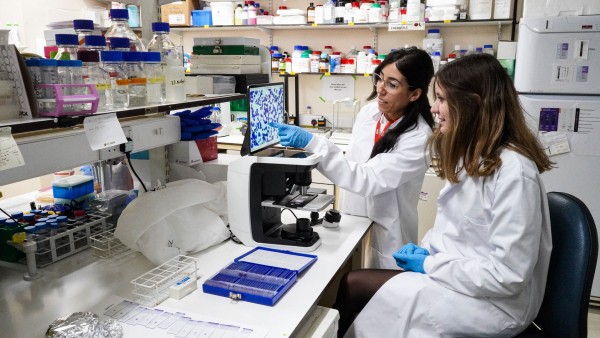28 March 2023
March marks Endometriosis Awareness Month of 2023. To raise the visibility of this often unrecognised and overlooked condition, King’s Health Partners (KHP) Women and Children’s Health rounds up the key facts about endometriosis and highlights a list of resources available for those who live with it.
What is endometriosis?
Endometriosis is a condition where the endometrial tissue––tissue that is similar to that of the lining of the uterus––grows in locations outside of the uterus, such as the ovaries or fallopian tubes. Endometriosis is estimated to affect 1 in 10 (about 190 million total) women of reproductive age around the world. It is a chronic disease that often yields excruciating symptoms, including:
- Moderate-to-severe pain during menstruation, sexual intercourse, bowel movements, and/or urination;
- Chronic pelvic pain;
- Abdominal bleeding;
- Nausea;
- Fatigue;
- Depression;
- Anxiety;
- Infertility.
Endometriosis is generally underdiagnosed due to its varied and broad symptoms. There is no known cure for the condition, and treatment generally consists of pain management. For more information, visit Cochrane’s article on Endometriosis Awareness Month 2023. Cochrane is a UK-based organisation that works to improve international healthcare by research and advocacy.
How to test for endometriosis
Luckily, in the UK, there is a wide range of resources available for those who have endometriosis. First, if you believe you may have endometriosis, it is recommended that you ask your GP for a referral to an NHS gynaecology clinic. Please see a list of accredited endometriosis clinics created by The British Society for Gynaecological Endoscopy (BSGE) here.
To test for endometriosis, your provider will likely conduct a transvaginal or transrectal ultrasound first. This is a non-invasive imaging procedure that aims to detect abnormal tissue growth and cysts. Ultrasounds can usually spot more advanced cases of endometriosis, but tends to be less effective when it comes to detecting the condition in its early stages. For this reason, your provider may want to conduct further tests to make a formal diagnosis.
To diagnose endometriosis with more certainty, your provider may want to conduct a laparoscopy. During a laparoscopy––also known as “keyhole surgery”––your provider will insert a small telescope into the abdomen to directly observe the internal tissue. This procedure is performed under general anaesthesia, and your provider may even be able to temporarily alleviate your symptoms by removing endometriotic cysts and scar tissue. To learn more about laparoscopy, visit the Endometriosis UK website here.
Finally, in some instances, an MRI may be performed to detect small signs of endometriosis, especially along the pelvic and bowel ligaments.
How is endometriosis treated?
Once diagnosed, there are a number of steps one can take to alleviate the symptoms of endometriosis.
Hormonal therapy: this approach aims to limit or stop the production of oestrogen in the body. This is because oestrogen is, in part, responsible for tissue growth and shedding. Thus, blocking oestrogen may shrink endometriosis tissue in the body and lessen the pain caused by the condition.
The main methods of hormonal therapy include:
- Combined oral contraceptive pill;
- Progestogens “including the intrauterine system (IUS), contraceptive injection, contraceptive implant, and progestogen-only pill” (NHS).
Many of these methods work to lower the risk of pregnancy, but none permanently impact fertility. However, hormonal therapy often yields side effects. It is important to note that hormonal treatment cannot remove existing endometriotic tissue and thus cannot improve fertility alone.
Surgery: this approach aims to physically remove the endometriotic tissue via a laparoscopy or hysterectomy.
Laparoscopy: a laparoscopy may be conducted to remove endometriotic tissue and cysts for pain relief. Small incisions are made in the abdomen and your provider will use a small tube with a light source and a camera to conduct the procedure. General anaesthesia is administered for a laparoscopy. It is worth noting that while a laparoscopy may provide temporary pain relief, endometriotic tissue may regrow.
Hysterectomy: a hysterectomy is a surgical procedure that partially or fully removes the uterus. It may also remove adjacent reproductive structures, including the fallopian tubes, cervix, and ovaries. After a hysterectomy is conducted, you will no longer be able to get pregnant.
- A hysterectomy is considered a major operation because it is irreversible. There is also a small chance that, if a partial hysterectomy is conducted, symptoms of endometriosis will return in the remaining tissues. For this reason, it is not regarded as the most suitable choice if the sole purpose of the operation is to reduce the symptoms caused by endometriosis.
- Following a hysterectomy, your provider may recommend that you undergo hormone replacement therapy (HRT). In many cases, women only take oestrogen after the operation, but your provider may recommend that you take progestin, too. This is because, when taken alone, oestrogen may spur the regrowth of endometriotic tissue in the reproductive structures that remain.
All surgeries carry the risk of complications. Read more about the risks of endometriosis surgery here.
Resources for endometriosis
Please see below a list of websites and resources for people living with endometriosis.
- Endometriosis UK: Resources;
- Royal College of Obstetricians and Gynaecologists: Endometriosis Patient Information Leaflet;
- Fertility Network UK: Access Support;
- National Institute for Health and Care Excellence (NICE): Endometriosis Diagnosis and Management;
- Royal College of Obstetricians & Gynaecologists (BSGE): Accredited Endometriosis Centres;
- Cochrane Gynaecology and Fertility: Endometriosis Awareness Month 2023.
Sources
- All About Endometriosis Action Month 2023 (Endometriosis UK);
- Your Laparoscopy (Endometriosis UK);
- Endometriosis (WHO);
- Endometriosis Overview (NHS);
- Endometriosis Treatment (NHS);
- Endometriosis Awareness Month 2023 (Cochrane);
- Endometriosis Ultrasound (Cleveland Clinic).
King’s Health Partners Women and Children’s Health’s vision is to be a centre for excellence in women and children’s health.




